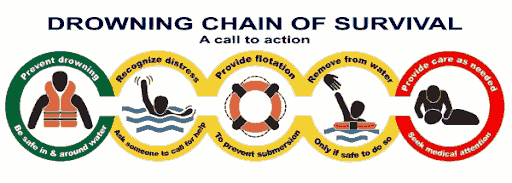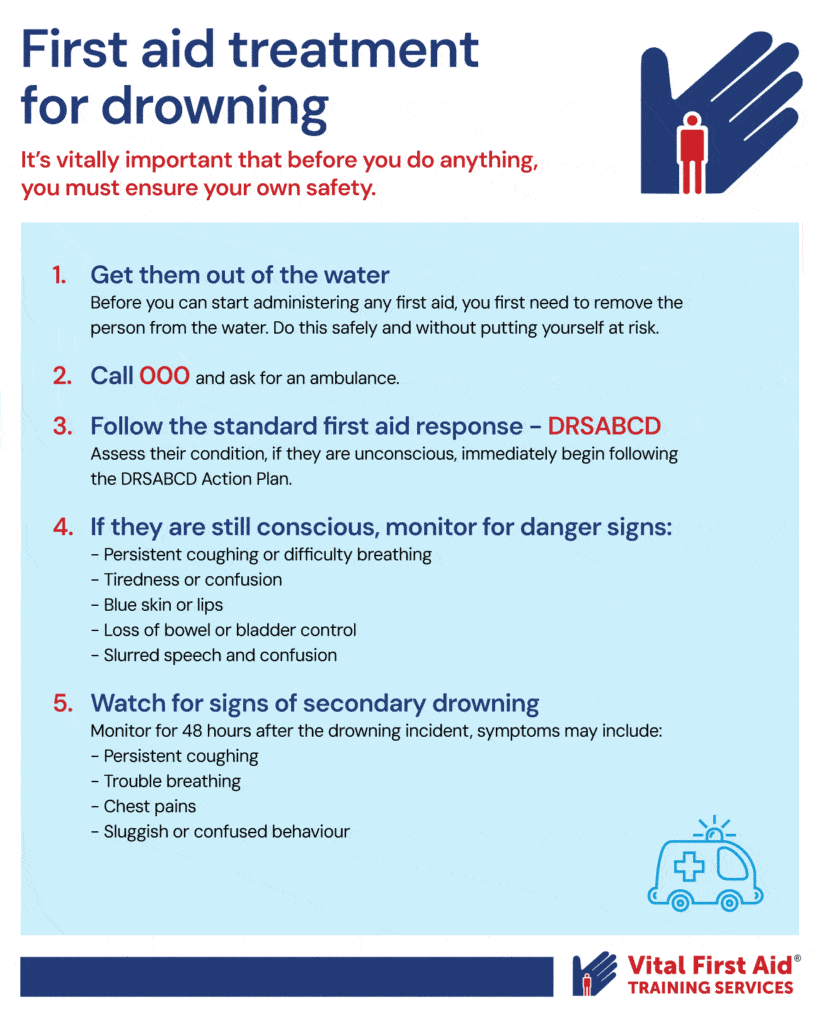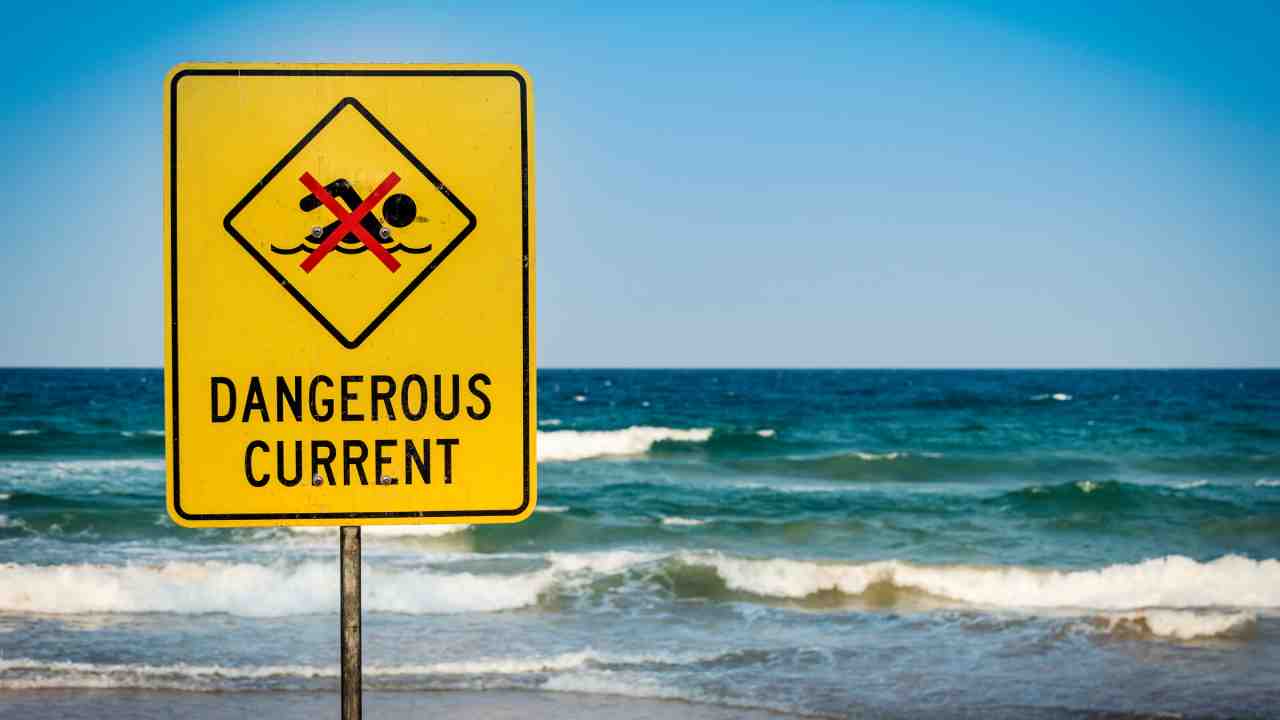The Vital Facts
- 281 Drowning deaths were recorded in Australia during 2022-2023
- 57% of drowning deaths were over the age of 45 years
- A significant majority, 77%, of drowning deaths were male
Source: Royal Life Saving Australia
Immediate first aid treatment for drowning:
- Get them out of the water
- Call 000 for an ambulance
- Follow the DRSABCD Action Plan
- If they are still conscious, monitor for danger signs including:
– Persistent coughing or difficulty breathing
– Tiredness, slurred speech or confusion
– Blue skin or lips
– Loss of bowel or bladder control - Watch for signs of secondary drowning for 48 hours after the incident
See here for more in-depth first aid treatment for drowning.
Jump to a section in this article:
- How Much of a Risk is Drowning?
- Preventing Drowning Accidents
- Keeping Kids Safe Around Water
- Providing First Aid for Drowning
- Make Sure You Know What to Do
For many Australian families, summer is synonymous with spending more time in and around the water. While this is a great way to beat the heat, it also poses a range of potential health and safety considerations. Most significantly, it increases the risk of drowning.
A basic knowledge of first aid for drowning is crucial to helping keep your friends and family safe. It allows you to identify potential issues and minimise the biggest risks.
That way, if the worst does happen, you will be prepared and know what to do.
How Much of a Risk is Drowning?
Drowning is broadly defined as experiencing breathing issues due to being submerged in liquid (usually water). It can be fatal and even those that survive can experience lifelong health issues as a result.
Because of our environment and lifestyle, the risk of drowning is quite high in Australia. According to Royal Lifesaving Australia, in 2023:
- 281 people drowned in Australian waterways
- 77% of drowning victims were men
- 57% were aged 45 or over
Preventing Drowning Accidents
The vast majority of drowning incidents are preventable, you just need to be aware of the risks. In particular, you should:
- Learn how to swim – even knowing just the basics will help
- Know the conditions – make sure the environment suits your swimming capabilities
- Use appropriate flotation devices – these should match the environment and your swimming capabilities
- Avoid alcohol – drinking alcohol significantly increases the risk of drowning
- Keep watch – drowning usually happens quickly and quietly, so it is important to look out for any signs someone is in trouble
Other health issues can also contribute to a heightened risk of drowning. To make sure you’re prepared for other common situations that can lead to accidental drowning, check out our guides on first aid for heatstroke, sunburn, and jellyfish stings.
Keeping Kids Safe Around Water
While the majority of drowning fatalities are adults, drowning is the leading cause of accidental death for children under 5 in Australia. Kids Alive – Do the Five is a national water safety campaign designed to help address this issue through awareness and education. It outlines five simple steps:
- Fence the pool – in NSW, pools that can be filled to more than 300mm must be securely fenced
- Shut the gate – pool gates should be designed to close automatically
- Teach your kids to swim – knowing how to swim increases both water confidence and safety
- Supervise – children and adolescents should be carefully monitored at all times in and around the water
- Learn how to resuscitate – if the worst does happen, knowing how to perform CPR could help save a life.
For more information on protecting your kids from drowning in a backyard pool, see our pool safety guide.
Providing First Aid for Drowning

If you see someone drowning, speed is the key to maximising their chances of survival. Follow the below steps as quickly – and safely – as possible.
1. Get them out of the water
Before you can start administering any first aid, you first need to remove the person from the water. Do this safely and without putting yourself at risk. Depending on the environment and conditions, this may mean you need to use a rope or buoyancy aid.
2. Call an ambulance
The impact of drowning can be deceptive. Even if you get them out of the water and conscious, you can’t be sure that they’re going to be okay.
That’s why whether they are unconscious or not, you need to call an ambulance as soon as you’ve got them out of the water.
3. Assess their condition
If the person is unconscious, immediately begin following the DRSABCD Action Plan. If they are still conscious, monitor for the following signs:
- Persistent coughing or difficulty breathing
- Tiredness or confusion
- Blue skin or lips
- Loss of bowel or bladder control
- Slurred speech and confusion
4. Watch for signs of secondary drowning
People who experience a drowning close call can develop a condition known as secondary drowning, which is reasonably rare, but can be extremely serious. In severe cases, it can be fatal.
Symptoms usually start to develop between 4 and 48 hours after the drowning incident and include:
- Persistent coughing
- Trouble breathing
- Chest pains
- Sluggish or confused behaviour
If you witness any of these symptoms, call an ambulance immediately.

Make Sure You Know What to Do
First Aid training is the best way to ensure you are prepared to respond to a medical emergency, including providing first aid for drowning.
With over 20 years of experience, Vital First Aid is a leading provider of accredited, practical first aid and pre-hospital care courses. Enrol online or contact us today to discuss your training requirements so we can book you in for a first aid course.



